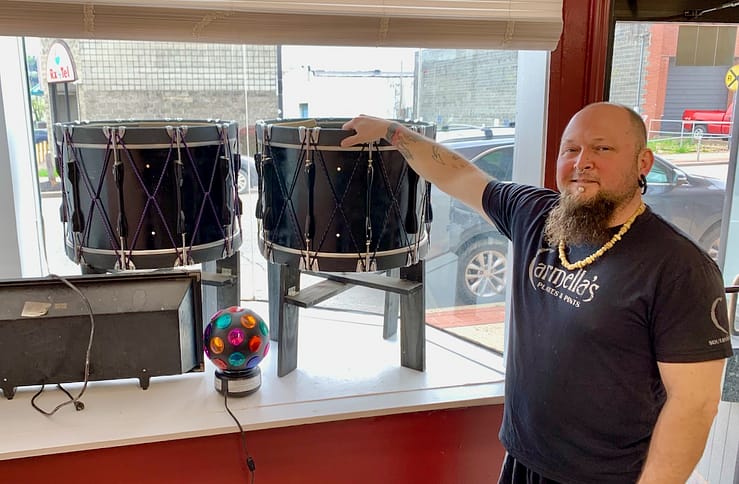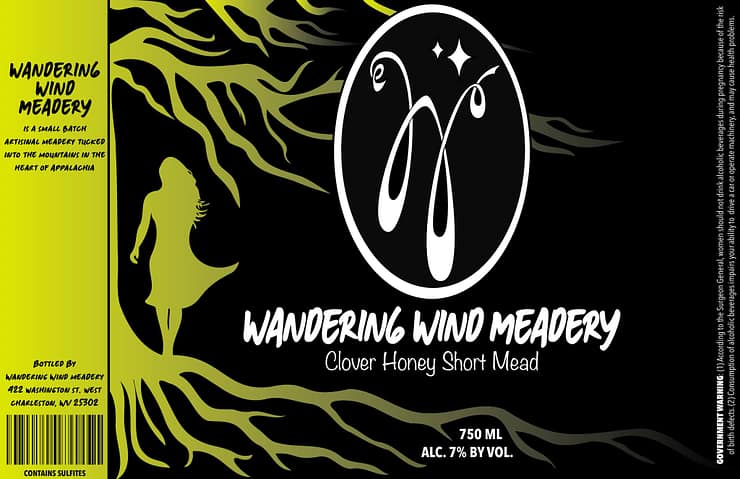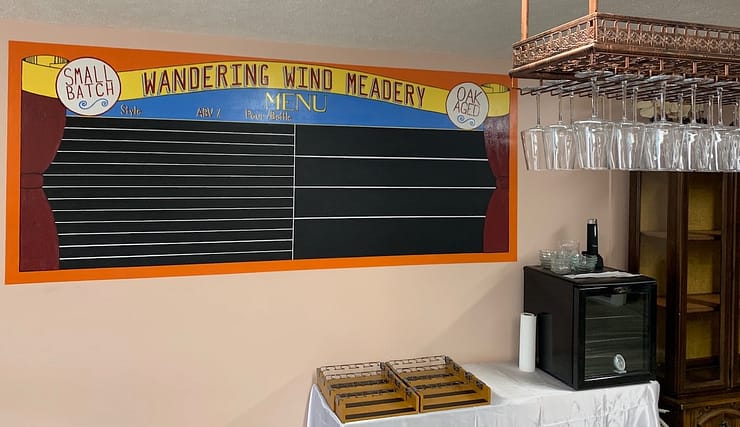
Welcome Wandering Wind Meadery
June 2, 2022
West Virginia’s newest meadery will soon open in Charleston’s Elk City district. Wandering Wind Meadery proprietors Dave Bragg and Dawn Parsons are adding their honey wines to the growing list of locally-made craft beverages we’re seeing emanate from the Capitol City.

The couple just received their final state winery permits yesterday. They plan to open their tasting room at 422 Washington St. West in mid-June.
In its purest form, mead is simply honey wine — honey, water, and yeast fermented into an alcoholic beverage. But today, mead takes so many forms—as long as the majority of the base fermentable is honey.
Similar to what you see craft brewers doing with beer, mead makers like Wandering Wind, are adding the widest array of fruits and natural flavorings and other fermentables to produce flavored meads and hybrid meads.
From Ren-Faires to Meadery

For 20 years David Bragg performed at Renaissance Fairs and Medieval reenactments. While doing that, he discovered mead, as mead is quite popular with the ren-faire community.
“I had some really good meads that piqued my interest, probably back around 2004,” says Dave of his ren-faire performing days. “It’s stronger alcohol than beer so you don’t have to drink as much. It’s more palatable to me than a lot of wines. Then, seeing all the flavors and all the things you can do with it opened up a lot of options.”
Bragg had also worked in kitchens for 25 years, where he spent a lot of time cooking. He says mead-making is basically a cooking process. Combing his love of mead with his cooking background, led him to start making his own mead at home.
Very much self-taught, Dave learned the process by reading books, participating in mead groups on Facebook, talking with friends who were mead makers, and by a lot of experimentation. Beyond mastering the fermentation process, he developed his skill for blending and balancing flavors, and putting together recipes.
When the pandemic shutdowns hit in early 2020, large gatherings like fairs and festivals were cancelled, leaving performing opportunities were few and far between. So what do you do with all your extra time? Begin a commercial meadery, that’s what.
Dave put aside performing and put his focus on making mead. That, in a nutshell, is the genesis of Wandering Wind Meadery.

Inspired by other commercial meaderies
Before he began making his own mead, he had not tried many commercial meads. Most all his experience with the beverage came from the products of other home mead makers. Once he joined the American Mead Makers Association, he began learning about commercial meaderies.
As he sampled commercial meads, he discovered Lost Cause Meadery in San Diego and was knocked out with their wide variety of flavors. “They were the first one I saw that had the avenue that I wanted go down.”
The owners of award-winning Lost Cause Meadery say this about their take on mead: “Besides being delicious, mead is THE most versatile alcoholic beverage there is. And to us that makes it the most exciting and fun to make and to drink. It can range from crazy complex, rich and super-sweet to refreshing and bone-dry. Unlike beer, wine or cider, the base sugar in mead (honey) can pair with almost anything—and, the options for honey varietals are endless.”
Dave also appreciates Shramm’s meads out of Michigan. “Ken Schramm wrote the mead makers bible: The Compleat Meadmaker,” he says. “It’s a handbook that every good mead maker should read.” Dave keeps his copy in his production room and refers to it often.
While Dave has no problem with the traditional, straight, unflavored styles of mead, his personal style preference falls squarely into the modern, specialty mead camp. “Honey itself doesn’t have a strong flavor,” he says, “so it’s a clean palette to start with. I like to play around more with the different adjuncts and flavorings — from coffee and chocolate to hot peppers, fruits and spices.”
Mead variants defined
Bragg loves the specialty fruited meads and mead hybrids, especially Melomels, Acerglyns, and Pyments. He experiments with flavors. The main types of mead variants you’ll find at Wandering Wind include:
- Fruited/Flavored Mead—fermented straight honey mead is then aged with fruits, spices or other natural flavoring agents (such as oak chips) and often back-sweetened with additional honey
- Short Mead—a honey wine purposely fermented with a lower alcohol content, typically around 5%. Similar idea to a session beer.
- Melomel—a category of mead where fruits or fruit juice is added to the honey and fermented together instead of adding fruit after fermentation.
- Pyment—a sub-category of melomel where grape juice is added to the honey and fermented together. “I make a Concord grape payment that I love,” Dave says.
- Acerglyn—maple syrup is added to the honey and fermented together.
- Cyser-—apple juice added to the honey and fermented together.
- Bochet—a portion of the honey is caramelized before fermenting.
Wandering Wind’s mead list

A tour of Wandering Wind’s production area uncovered a exciting set of super-flavored test batches of mead. You can expect meads like these and/or other similar small-batch meads to be sold at opening. Some examples are:
- Vanilla Chai Mead — traditional mead aged on vanilla beans and chai tea
- Clover Honey Short Mead — a lighter, lower alcohol mead flavored with citrus, coriander and oak
- Irish Sailer’s Mead — a traditional mead aged with lavender, heather tips, juniper berries, rose hips, orange peel, and oak chips
- Berry Mocha Melomel — blend of blueberry, blackberry and raspberry fermented with the honey and then aged on coffee beans and dark chocolate
- Concord Grape Pyment — concord grape juice mixed with honey and fermented
- Blueberry Acerglyn — maple syrup mixed with honey and fermented. Aged on blueberries.
- Orange Maple Acerglyn — maple syrup mixed with honey and fermented. Lactose added. Aged with orange peel.
- Apple Pie Cyser — apple juice added to honey and fermented. Pie spices added.
- Traditional Mead — fermented honey flavored with orange peel and coriander
- Midnight Mojito — a traditional mead aged with mint, lime, and colored flower petals (for coloring)
- Thai Chili Pepper Mead — traditional mead flavored with peppers, cardamon, coriander, ginger, orange peel, toasted oak chips.
Building a retail meadery operation

Dave and Dawn did most all the build out, remodeling, and decorating of their mead production area and tasting room themselves. It was a slower process, but it saved them from going deep into debt. Dave does the mead making, and Dawn handles marketing and sales. Both Dawn and Dave will share time staffing the tasting room bar.
Wandering Wind Tasting Room
Wandering Wind’s state winery license will allow them to sell mead by-the-glass at the tasting room. Dave says they will also feature mead flights to help customers get acquainted with the variety of meads he produces. They will offer free, small tastes of the meads. Bottles of mead will be sold for customers to take home. They will also make their tasting room available to rent out for special tasting events, meetings, and receptions.
Watch for mead tasting events on their upcoming agenda. Dave envisions these events as something around a $20 ticket, where customers would get to sample every mead they have. Possibly with some kind of live entertainment and finger foods included.
A membership club is also envisioned where members receive special perks and opportunities for unique limited edition meads only available to members. About the affinity of mead making with homebrewers, Dave says, “I’d love to have the local homebrewers in for a meet up and to share ideas.”
Mead making process takes time

Wandering Wind is a small-batch meadery where the meads are produced in 5 to 15 gallon batches. Nothing is rushed. Time is given where time is needed.
To make a basic mead, the primary fermentation process takes about 4 weeks. When the primary fermentation is complete, the base mead is transferred to a new vessel (called the secondary) where fruits and/or flavoring ingredients are added. Depending on the type of flavoring additions (fruit, coffee beans, herbs, spices, etc.), it may take two to four weeks to develop the desired flavors.
Back-sweetening the mead is also done in the secondary tank. For back-sweetening, Dave may use varietal honey, lactose, maple sugar, caramel syrup, or other natural sweetener. He likes to puts a variety of sweetness levels into his different meads. “You want some sweeter; you want some drier,” he says. “Everyone has different tastes.”
Wandering Wind’s mead-aging process ends with two weeks on oak—using wood chips which are put into the tank. The oak aging gives a little bite to the finish that Dave likes. “It was a style choice I made early on,” he says.
Like many contemporary wine makers, Wandering Wind Meadery adds agents to the mead that puts the yeast to sleep to prevent secondary fermentation from occurring. This allows any added fruit or back-sweetening to remain fresh and sweet tasting without the yeast drying it out.
The final step is filtering. All Wandering Wind meads run through a three-step filtering system to clarify them. The mead is then bottled for sale. Initially, all Wandering Wind meads will be sold in 750ml bottles.
Wandering Wind Meadery
422 Washington Street West
Charleston, WV 25302
Facebook Page Link

